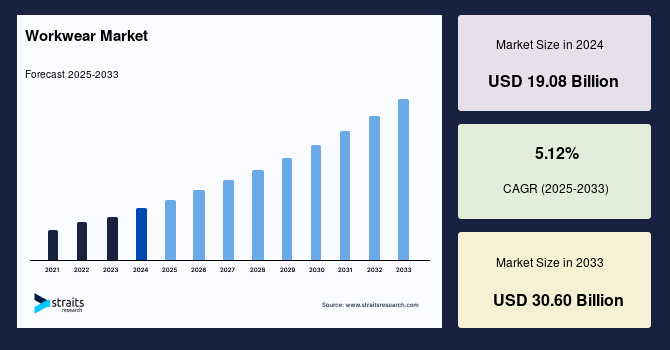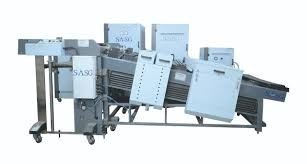Global Workwear Market Share & Growth Analysis by 2033

Global Workwear Market: An In-Depth Overview of Trends, Growth Drivers, Challenges, and Future Prospects
Introduction
Workwear plays a critical role across various industries worldwide, functioning as more than just clothing — it’s vital personal protective equipment (PPE) that safeguards workers while boosting productivity and promoting company branding. From construction sites and manufacturing plants to hospitals and hospitality, workwear is essential for safety, compliance, and professional appearance.
The global workwear market size was valued at USD 19.08 billion in 2024 and is projected to grow from USD 20.06 billion in 2025 to USD 30.60 billion by 2033, exhibiting a CAGR of 5.12% during the forecast period (2025–2033).
The global workwear market is on a solid growth trajectory, fueled by rising industrial activities, evolving safety standards, and advancements in textile technology. Valued at approximately USD 19 billion in 2024, it is expected to expand to over USD 30 billion by 2033, growing at a compound annual growth rate (CAGR) of around 5%.
What Constitutes Workwear?
Workwear is a broad category that includes:
Protective Clothing: Flame-resistant, chemical-resistant, anti-static, and high-visibility gear designed to protect against workplace hazards.
General Workwear: Durable clothing suited for day-to-day industrial work.
Corporate Uniforms: Branded clothing used for identification and professional appearance in sectors like hospitality, retail, and healthcare.
Smart Workwear: Equipped with embedded sensors to monitor worker health, environmental conditions, and safety risks in real-time.
Key Market Drivers
1. Growing Emphasis on Worker Safety and Compliance
Governments and regulatory bodies globally are tightening workplace safety laws, compelling industries to adopt advanced workwear solutions. For example, regulations mandating flame-resistant clothing for oil and gas workers or high-visibility gear for construction sites are driving demand.
2. Rapid Industrialization and Urbanization
Emerging economies in Asia-Pacific, Latin America, and Africa are experiencing infrastructure booms and expanding manufacturing sectors. This growth fuels demand for workwear to protect an increasing workforce.
3. Technological Innovation and Smart Wearables
New developments include temperature-regulating fabrics, moisture-wicking materials, and smart sensors that monitor fatigue, heart rate, or exposure to hazardous gases — enhancing safety and productivity.
4. Sustainability and Eco-Consciousness
There is increasing consumer and corporate focus on environmentally friendly products. Brands are innovating with organic cotton, recycled fibers, and biodegradable textiles. Circular economy initiatives, including recycling and take-back programs, are becoming mainstream.
Challenges Facing the Market
High Cost of Advanced Workwear: Smart and sustainable clothing commands premium prices, which can limit accessibility for smaller businesses or developing markets.
Complex Regulatory Environment: Compliance with multiple international standards (e.g., OSHA, EN, ISO) requires manufacturers to continuously innovate and certify their products.
Comfort vs Protection: Achieving the right balance between worker comfort and effective protection remains an ongoing challenge.
Market Segmentation
By Product Type: Protective workwear holds the largest share due to strict safety needs, followed by general and corporate uniforms.
By End-Use Industry: Manufacturing, construction, oil & gas, healthcare, and hospitality are key sectors driving demand.
By Distribution Channel: Direct sales dominate, with e-commerce and retail channels growing rapidly due to convenience and customization options.
Regional Insights
Asia-Pacific
Asia-Pacific dominates the market thanks to its vast labor force and fast-paced industrial growth. Countries like China, India, Japan, and Southeast Asian nations are key contributors. Rising safety awareness and improving standards in these regions will continue to drive adoption.
North America
North America is a hotspot for innovation, especially in smart workwear and sustainable fabrics. Growth is driven by construction, healthcare, and manufacturing sectors, with high regulatory enforcement.
Europe
Europe’s market is shaped by stringent safety laws and environmental regulations. The focus on sustainable workwear and circular business models is strong, supported by government incentives.
Emerging Trends and Innovations
Smart PPE: Wearables that provide real-time health and safety alerts to prevent accidents and reduce downtime.
Sustainable Materials: Use of recycled plastics, organic fibers, and eco-friendly dyes reducing environmental impact.
Customization & Branding: Increasing demand for personalized uniforms that enhance corporate identity.
Digital Transformation: Growth of online platforms offering tailor-made workwear solutions with faster delivery and better fit.
Future Outlook
The future of the workwear market looks promising, with growth driven by:
Continued industrialization in emerging markets.
Rising safety compliance worldwide.
Technological advances making workwear smarter, more comfortable, and eco-friendly.
Increasing digital adoption transforming distribution and customization.
Companies investing in R&D for innovative materials and connected PPE, while embracing sustainability, will lead the competitive landscape.
Conclusion
The global workwear market is evolving rapidly, becoming more sophisticated and sustainable. From heavy-duty protective gear to smart wearable tech, workwear is essential for workplace safety and efficiency. As industries worldwide continue to prioritize worker welfare and environmental responsibility, the demand for innovative and eco-conscious workwear solutions will only grow stronger.
About Us
StraitsResearch.com is a leading research and intelligence organization, specializing in research, analytics, and advisory services, along with providing business insights & research reports.
Contact Us:
Email: [email protected]
Website: https://straitsresearch.com/
Note: IndiBlogHub features both user-submitted and editorial content. We do not verify third-party contributions. Read our Disclaimer and Privacy Policyfor details.







